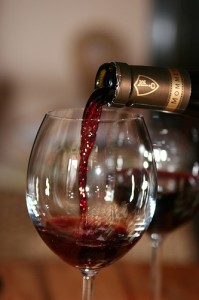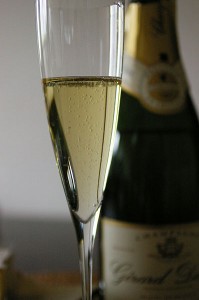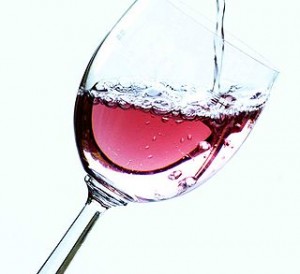“How do you like the wine?” my husband asked me, after pouring a traditionally-styled 2001 Chianti Classico Riserva. “I find it blousy and a bit unfocused,” I replied. “Let’s try it in narrower glass.” Sure enough, the narrower glass reined the wine in, and some concentration became evident.

This situation is typical for us. We choose a glass type that would seem to be the logical one for the wine we are having, and then mid-stream we pull out a different type of glass entirely, in an attempt to enhance or correct the experience of the wine. In restaurants, when we think a wine could taste better than it does, we ask for a smaller glass, or a larger glass, or a glass of a different shape, depending on the circumstances.
That the shape and the quality of a glass can change the experience of a wine has become accepted fact since the Riedel team began hosting comparative glassware tastings about 20 years ago. But much of the take-away about glassware among wine drinkers, in my experience, has centered around olfactory characteristics that you can perceive in one glass rather than another. In general our local wine culture focuses so much on the aromatics of wines rather than their structure—the litany of aromas and flavors that you see on back labels and in tasting notes rather than body, texture, sweetness, and so forth. As someone who is more interested in the structural aspects of a wine than its specific aromas and flavors, my continuing fascination about glassware is that the glass shape can modify the texture, weight, and balance of a wine.
In The Taste of Wine, Émile Peynaud suggests that wine’s taste has architecture. “However lacking in imagination he might be,” Peynaud writes, “when a taster works the wine in his mouth, he absorbs…impressions of volume, form and consistency. He forms a physical image of the wine…The wine does not appear to be what it really is, namely an elusive fluid film just wetting the palate’s surface; instead it feels like a substance with three dimensions.” We describe wines as lean, round, fat, solid, tight, loosely-knit, or taut, for example, according to the mental picture that the wine’s structure gives us.

Wine glasses have architecture, too. And it seems to me that the shape and size of a glass mirrors the structural experience of a wine.
Again and again, I have noticed that a narrower glass creates a leaner, more concentrated taste in a wine and a wider glass creates a fuller, more loosely-knit effect. When a wine tastes too high in alcohol for me or its fruit character seems too diffuse, I try a smaller, narrower glass to bring the wine into a different focus—bring it down to size, so to speak—which often minimizes the impression of alcohol. When a wine is too tight, too dense, or too oaky, I find that a larger glass or a rounder glass can expand its taste and bring it alive, often minimizing the impression of oakiness.
Of course I have considered whether power of suggestion is the operative factor. And glassware developers and scientists can explain whether my experience is accurate or not. But for me, the glass shape and size has become a very useful tool for making wines more enjoyable. Trying a wine in several glasses has also become a game that I enjoy playing. (Luckily, I am not the designated glass-washer in our family.) The differences in a wine’s taste can be subtle or dramatic, but I always find a difference.
When I taste a wine in one type of glass, describe the taste in detail in my tasting note, and then expand my description based on the wine’s taste in a different glass, I am struck by how utterly, incontrovertibly subjective wine tasting is. Even when all the other variables are eliminated—the bottle and closure, the temperature of the wine and the weather, the company, other aspects of the environment, your own health and disposition, and so forth—a wine can still taste different, to the same taster, according to the glass.
How can we be so presumptuous as to fix the taste of a wine in words, let alone ascribe a qualitative score to it? Critics and wine writers do it, I do it, because wine drinkers want to know how a wine tastes, and where it ranks in quality. But in reality, any tasting note is merely a record of a single, subjective experience about which the reader knows almost no details, except the reputation of the critic and, if he or she has been following that critic, to what extent the critic’s personal taste jibes with his or her own.
 When I do comparative blind tastings, I level the playing field by always using the same type glass, as is common practice for most critics. (My default glass is the short-stemmed Riedel white wine glass.) And lately, when I conclude that I prefer a wine in a particular shape of glass, I am likely to say so in my review of that wine. But an editor has told me that specifying a glass type makes wine too complicated. Wine drinkers, I suppose, want concrete information. As if!
When I do comparative blind tastings, I level the playing field by always using the same type glass, as is common practice for most critics. (My default glass is the short-stemmed Riedel white wine glass.) And lately, when I conclude that I prefer a wine in a particular shape of glass, I am likely to say so in my review of that wine. But an editor has told me that specifying a glass type makes wine too complicated. Wine drinkers, I suppose, want concrete information. As if!
The subjectivity of wine tasting is a strong argument in favor of more critics, who generate more opinions so that readers can cull some common truth from the multiple reviews, to the extent that they have time to read them. It is also a lesson in humility for critics. Ultimately, every wine drinker experiences a wine in his own way in his own environment, through the filter of his personal experience, not to mention using his own personal nose and mouth.
The subjectivity of wine tasting also underscores the need for wine drinkers to think for themselves and trust their personal opinions about a wine. Critics can be guides, and their opinions can be yardsticks for learning, but the enjoyment of wine is inherently a democratic exercise.
 Mary Ewing-Mulligan is the first woman in America to become a Master of Wine, and is currently one of 27 MWs in the U. S. In addition to operating International Wine Center and teaching WSET Diploma-level classes there, she is a freelance wine writer, an author, a speaker and a wine judge. Mary is past president of the Institute of Masters of Wine (North America), and Executive Director of U.S. Programs for WSET.
Mary Ewing-Mulligan is the first woman in America to become a Master of Wine, and is currently one of 27 MWs in the U. S. In addition to operating International Wine Center and teaching WSET Diploma-level classes there, she is a freelance wine writer, an author, a speaker and a wine judge. Mary is past president of the Institute of Masters of Wine (North America), and Executive Director of U.S. Programs for WSET.

